| COVID-19(新型コロナウイルス感染症 情報: 公共交通機関やその他の状況ではフェイスマスクが義務付けられており、リスクの高い国からの旅行者は入国する必要があります 検疫 14日間。距離、衛生状態などに関する推奨事項が適用されます。を参照してください 国の情報. | |
| (情報の最終更新日は2020年7月21日) |
スイス (ドイツ人: シュバイツ, フランス語: スイス, イタリアの: Svizzera, ロマンシュ語: Svizra)、正式には スイス連邦 (ラテン語: Confoederatio Helvetica、略語「CH」)は山岳国です 中央ヨーロッパ.
スイスは山で知られています(アルプス 南部で、 ジュラ 北西部)が、なだらかな丘、平野、大きな湖の中央高原もあります。最高点は4,634m(15,203フィート)のDufourspitzeです。 マッジョーレ湖 海抜195m(636 ft)であり、温暖な気候は標高によって大きく異なります。
スイスは、おそらく他のどのヨーロッパの国よりも本質的に文化的に多様です。歴史的にさまざまな地域で支配的であった4つの国語があります。 カントン。ドイツ語、フランス語、イタリア語はそれぞれの国に隣接する地域で話されており、ロマンシュ語(スイス起源のロマンス諸語)はの山岳地帯で話されています。 グラウビュンデン。スイスはまた、比例して最大の外国人/移民人口の1つを持っています-ほぼ850万人の住民の文字通り4人に1人の居住者(2018年時点で25.1%)は外国人です-世界のほぼすべての国籍と民族グループで構成されています。寛容、中立、直接民主主義、そしてほぼ伝説的な豊かさで有名なスイスは、世界で最も高い生活水準の1つであり、それに匹敵する価格を誇っています。
スイスは、ハイキングブーツ、スノーボード、または良い本とサングラスを詰め込んだかどうかにかかわらず、素晴らしい旋風の旅になる可能性があります。
地域
政治的に、スイスは26に分かれています カントン、ただし、旅行者は次の地域の方が便利です。


| スイス西部 ジュネーブ湖とアルプスの北岸からジュラまで。 |
| ベルン地方 伝統的なベルンの影響の中核地域 |
| ベルナーオーバーラント 雄大なベルナーアルプス |
| 中央スイス スイス連邦の発祥の地とウィリアムテルの伝説 |
| スイス北西部 スイスの製薬産業の文化、芸術、そして本拠地。隣接するドイツとフランス |
| チューリッヒ 広大な大都市圏を持つ国内最大の都市 |
| スイス東部 アルプスとボーデン湖の間、ザンクトガレン修道院、アッペンツェルのなだらかな丘の上にある多くの風光明媚な酪農場の本拠地 |
| ヴァレー スイスの最高峰とヨーロッパ最大の氷河 |
| グラウビュンデン 公式には3か国語で、 グリソン、この地域は非常に山が多く、人口が少なく、多くの素晴らしい観光地があり、古代ロマンシュの少数民族の言語と文化があります。 |
| ティチーノ 有名な高山湖を含むイタリア語圏 |
ザ・ スイスアルプス の東部の地域を介してストレッチ ジュネーブ湖, ヴァレー, ベルナーオーバーラント、南部 中央スイス、ほぼ全体 ティチーノ 最南端を除いて、最南端 スイス北東部、および グラウビュンデン.
都市
- 1 ベルン (ベルン)—この高度に発展した国が、ほぼすべての通りに沿ってアーケードがあり、驚くほどよく保存された旧市街のある首都に近づくのと同じくらい近くにあります。素晴らしいレストランやバーがたくさんあります
- 2 バーゼル —東から到着し、北に向かって出発するライン川の直交する曲がり角にある、ドイツのラインラントと黒い森、フランスのアルザスへの旅行者の玄関口。
- 3 ジュネーブ (ジュネーブ)—この芸術と文化の中心地は、約200の政府および非政府組織、CERNのワールドワイドウェブの発祥の地、および赤十字国際委員会(ICRC)の本拠地である国際都市です。
- 4 インターラーケン —スイスのアウトドアおよびアクションスポーツの首都。スカイダイビング、バンジージャンプ、ハイキング、急流下りからキャニオニングまで、何でも
- 5 ローザンヌ —風景、食事、ダンス、ボート遊び、そしてスイスのワインカントリーが魅力です
- 6 ルツェルン (ルツェルン)—中央地域の主要都市で、スイスの初期の歴史のすべての場所に直接水がつながっています。
- 7 ルガーノ —ゴージャスな旧市街、美しい湖。多く Italianatà スイスの真剣さと相まって
- 8 ザンクトガレン —スイス北東部の主要都市。 ザンクトガレン修道院、ユネスコの世界遺産に登録されており、特別な場所への門としても機能します。 アッペンツェル 領域
- 9 チューリッヒ (チューリッヒ)—スイス最大の湖畔の都市であり、銀行と文化の主要な中心地であり、数多くのレストランがあり、ナイトライフが盛んです。
その他の目的地
- 1 ダボス —世界経済フォーラムの年次総会が開催される大規模なスキーリゾート
- 2 グリンデルヴァルト —アイガーのふもとにあるクラシックなリゾート
- 3 ラヴォー —ジュネーブ湖のほとりにある段々になったブドウ園の地域とユネスコの文化遺産
- 4 サンモリッツ —の派手なスキーリゾート エンガディン スイス南東部の谷
- 5 ユングフラウアレッチ —アルプス最大の氷河地帯周辺の保護地域。この高山の公園からは素晴らしい景色を眺めることができ、ユネスコの自然遺産にもなっています。
- 6 ツェルマット —強大なマッターホルンのふもとにある有名なマウンテンリゾート
理解する
歴史
スイスには、はるか昔にまで遡る歴史があります。 ローマ帝国 当時、そこに住む部族はローマの情報源によって「ヘルヴェティイ族」と呼ばれていました。したがって、現代のラテン語の名前「Confoederatio Helvetica」は、国の公用語を優先することが推奨されない場合は常に内部で使用されていました。スイスの組織や企業の名前には、「Helvetia」または「Helvetic」への参照が多数あります。国際登録レターとスイスのトップレベルインターネットドメインは、それぞれCHと.chです。ジュリアスシーザーとヘルヴェティイ族の間の喧嘩は、シーザーの デベロガリコ、これは今でも世界中のラテン語の学生に読まれています。
ヘルヴェティイ族とその後継者たちは、ヨーロッパの他の地域で流行している封建制や独裁政治ではなく、さまざまな形態の民主主義と権限委譲を採用して、北欧諸国でしか見られないゲルマンの伝統を保存し、ある意味で近代化しました。何世紀にもわたって(当初は非常に緩い)連合として機能していたこの国は、ヨーロッパで最も多様な国の1つに成長しました。また、国や地域のアイデンティティと、幅広い市民の決定を下すために採用された直接民主主義を鮮やかに祝っています。スイスの独立は段階的なプロセスであり、長い間唯一の文書でした すべて カントンが署名したのはフランスとの同盟でしたが、1648年までに ヴェストファーレン平和、神聖ローマ帝国は、スイス連邦の領土(および ネーデルラント共和国)、そしてスイスの運命は、ドイツ南西部またはアルザスの他のアレマンの州の運命から分岐し始めました。 19世紀のスイスのロマンチックなナショナリズムは、1848年の分離同盟戦争の後にのみ実際に達成された統一を投影し、最初の3つのカントンであるウリ、シュヴィッツ、ウンターヴァルデンの代表者がリュトリの牧草地で誓った相互扶助の誓いを神話化します。正確な日付は不明ですが、伝統はそれを、おそらくスイス統一のこの最初の行為を文書化した1291年の文書と関連付けています。ハプスブルク家の大君主に反抗したウィルヘルム・テル(ドイツの劇作家シラーによって舞台劇にも変換された)の物語もこの時代にさかのぼります。
スイスの独立と中立は長い間ヨーロッパの主要国によって尊重されており、スイスはそれ以来国際戦争に関与していません。 ナポレオン時代 そして1850年代から内部的に平和でした。過去半世紀にわたるヨーロッパの政治的および経済的統合、ならびに多くの国連および国際機関におけるスイスの役割は、スイスとその近隣諸国との関係を強化してきました。しかし、この国は2002年まで国連加盟国にならず、外交において中立的な立場を維持しています。そのすべての隣人とは異なり(バー リヒテンシュタイン)、スイスはのメンバーではありません 欧州連合.

気候
ザ・ スイスの気候[リンク切れ] 温帯ですが、アルプスの標高によって大きく異なります(1000 mごとに平均約6.5°C)。 4つの主要な気候地域[リンク切れ]:中央高原の北東部と西部、スイス南部、およびアルプス内。
主に気温と日照時間の変化をもたらす4つの明確に定義された季節があります:12月から2月までの短い日で雨または雪の寒い冬、3月から5月までの融雪と花を吹く春、適度に暖かいから時々暑いですがまた、6月から8月までの長い日を伴う非常に雨の多い夏、色とりどりで非常に乾燥していることもあり、驚くほど暖かいこともありますが、9月から11月まではすでにかなり寒くて霧の深い秋であり、日がどんどん短くなっています。そして 各季節または月は年ごとにかなり異なる可能性があります[リンク切れ].
スイスは寒く、中央高原の低い場所では、しばしば曇り、雨、雪の冬があり、中程度から暖かい夏は非常に変わりやすく、特に暑い夏の日や山では非常に急速に変化する可能性があります。極端な場合、数分以内に。曇り、雨、湿気の多い夏の日を経験する年もありますが、他の日や翌年は非常に晴れ、時には時々にわか雨が降るだけの暑い夏の日もあります。年間を通して約3日おきに雨が降り、短いにわか雨が降るか、一日中雨が降り続けます。また、雨季は季節を問わず1時間未満から3週間まで耐えることができます。 気象予報 6日以上先は、科学的に根本的に信頼できません。
最も便利で、したがって最も訪問される月は、5月下旬から10月上旬で、7月から8月にかけて、特に混雑することがよくあります。ハイキング、クルーズ、電車、または自転車に乗って、その素晴らしい風景を楽しむことができます。ハイアルプス、そのブラックノーズの羊、氷河を発見することができます。夏のシーズンは、夏のスキーは限られていますが、相容れないと思われるもの、つまり湖でのビーチホリデーといくつかを組み合わせることができます。冬には、観光客や地元の人々がさまざまな種類のウィンタースポーツを楽しんだり、前は魅惑的なクリスマスの雰囲気を楽しんだり、年末以降は面白いカーネバルシーズンを楽しんだりします。
多様性
スイスは、ヨーロッパで最も特徴的な3つの文化を紹介しています。北東には、清潔で正確な、8対5で機能し、より硬いスイスドイツ語を話すスイスがあります。南西には、フランス人から知られているワインを飲みながら自由放任主義のスタイルがあります。アルプスの南、南東にある太陽は、イタリアンスタイルの広場でうろついているカプチーノシッパーを暖めます。そして中央には、古典的なスイスのアルプホルンと山の風景があります。それをすべて結びつけることは、独特のスイスの考え方です。スイスは、民族や言語ではなく、国になりたい、周囲のドイツ人、イタリア人、フランス人とは一線を画したいという理由から、「選択国」と呼ばれることもあります。異なるグループ間で対立が生じることもありますが、スイスの共通のアイデンティティは通常、分割要因よりも強力です。
ほとんどのカントンは、ロマンシュ語を話す小さな地域を除いて、近隣諸国と共通の言語を使用していますが、そこで話される言語は、必ずしも国境を越えて同じであるとは限りません。特に、スイスドイツ語は、で話されているドイツ語のバリエーションとは大きく異なります。 ドイツ または オーストリア、独自の発音と語彙を備えています。標準ドイツ語の流暢な話者でさえ(Hochdeutsch)路上やマスメディアで話されている通常のスイスドイツ語を理解するのに苦労するかもしれません。訪問者にとって幸いなことに、ほとんどのドイツ語を話すスイス人は完全に話すことができます Hochdeutsch、英語、および少なくとも1つの他の国語(フランス語など)。書面でさえ、スイス標準ドイツ語はドイツ語やオーストリア語とは著しく異なりますが、ほとんどの違いはわずかであり、スイスが文字「ß」を使用せず、次のように置き換えていることに気付く可能性が最も高いです。 「ss」。ただし、発音には影響しません。スイスフランス語とスイスイタリア語は、他の国で話されている対応するものとは語彙的にのみ異なります。ただし、ロマンシュ語は、ほとんどの人が少なくとも1つの他のスイス語も話す遠隔のアルプスのコミュニティでのみ話されています。
経済

スイスは平和で繁栄し、安定した現代の市場経済であり、失業率が低く、熟練した労働力があり、一人当たりのGDPはヨーロッパのほとんどの大国よりも高くなっています。金融の専門知識で長い間認められてきたスイスは、国際競争力を強化し、最大の貿易相手国であるEUとの円滑な貿易を確保するために、経済慣行をEUとほぼ一致させてきました。スイスは、ある程度の銀行秘密を維持し、フランの長期的な対外価値を維持しているため、投資家にとって安全な避難所であり続けています。スイスフランは「安全な避難所」と見なされてユーロとほぼ同等に上昇し、有名なスイスの銀行秘密はアメリカ、ドイツの財政事務所からますます攻撃されているため、これらの両方が疑問視されていますスイスの銀行を介した脱税の多くの注目を集める事件が法廷に持ち込まれました。それでも、失業率はEU平均の半分以下にとどまっています。これと為替レート(特にユーロ)により、スイスは世界で最も高価な目的地の1つになっています。
スイスは所得税率が比較的低いことでも知られており、世界で最も裕福な人々に人気のタックスヘイブンとなっています。
祝日
祝日 州レベルで規制されており(8月1日を除く)、大きく異なる場合があります。ただし、これらは(ほとんど)どこでも観察されるものです(日曜日に常に行われるものを除く):
- 元旦 (1月1日)
- 良い金曜日 (イースターの2日前、カントンの祝日ではありません ティチーノ そして ヴァレー)
- イースターマンデー (イースターの1日後、ヴァレー州で法的に認められていない休日)
- 上昇 (イースターから39日後)
- ウィットマンデー (ペンテコステの1日後、ヴァレー州で法的に認められていない休日)
- スイス建国記念日 (8月1日)
- クリスマス日 (12月25日)
- 聖ステファノの日 (12月26日、カントンの祝日ではありません ジュネーブ, ジュラ、ヴァレー、 ヴォー とカントンの一部 ゾロトゥルン)
祝日 公共交通機関、特にSBB CFF FFSとPostBusの時刻表では、次のようになっています。 1月1日と2日, 良い金曜日, イースターマンデー, 上昇, ウィットマンデー, 8月1日, 12月25日と26日。地方事務所の営業時間や地方運輸会社の時刻表も地方の祝日に従う場合があります。
政治

スイスには連邦政府のシステムがあり、26の州に分かれており、各州には独自の憲法、政府、警察があります。連邦政府はその中にあります 連邦都市, ベルン.
連邦議会はスイスの連邦議会として機能し、各州にも独自の議会があります。 7人のメンバーで構成される連邦参事会はスイスの連邦行政機関です。他の国とは異なり、スイスには国家元首または政府の長として一人の人物がいません。むしろ、連邦参事会全体が集合的に両方の役割を果たします。スイス連邦の連邦大統領の地位は、毎年7人の評議員の間で交代し、その年の副大統領が来年の大統領になります。それとは別に、しかし、彼または彼女は 初期対等期間、他の6人の評議員を超えて権力を持っていない。
スイス国民は通常、連邦、州、地方自治体の3つの異なる政治レベルでさまざまな問題に年に4回投票します。 1995年1月から2005年6月の間に、スイス市民は連邦のみの問題に31回投票し、さらに多くの州および地方自治体の質問に加えて103の連邦質問に回答しました(同じ期間に、フランス市民は2つの国民投票にのみ参加しました)。大衆は、憲法を含むあらゆる問題を要求したり、議会の決定と矛盾したりする可能性があります。最も頻繁なテーマは、社会問題(例:福祉、ヘルスケア、薬物政策)、公共インフラ(例:公共交通機関および建設プロジェクト)および環境問題(例:環境および自然保護)、経済学、財政(税金を含む)、移民、庇護、教育だけでなく、文化とメディア、国家システム、外交、軍事問題についても、3つの政治レベルのいずれかで!世論調査に頻繁に呼ばれる国にとっては驚くことではないかもしれませんが、中央ヨーロッパの基準では投票率が必ずしもそれほど高くない場合があります。
民衆の権利として知られるこのシステムのいくつかの主要な手段には、連邦イニシアチブ(民間人、公的グループ、または政党によって開始される)を提出し、あらゆる問題について憲法上または立法上の国民投票を提起する権利が含まれます。結果は常に政府を拘束します—「大衆が最終決定を下します!」これにより、スイスはすべての政治レベルで非常に高い人気を博し、「世界で唯一の直接民主主義」と呼ばれるようになりました。しかし、投票した人の中には恥ずかしいと見なされたイニシアチブが「創造的に解釈」されたり、後の国民投票によって完全に取り消されたりしたこともあります。スイスと同様のレベルの「人気のある法律」を持ついくつかの準国の管轄区域があり、スイスはEU加盟国ではありませんが、EUとの多くの二国間条約に拘束されていますが、他の人と同じ国民投票の可能性があります。他の法律。
スイスの民主主義の豊かさは、30を超える多くの政党にも表れています。そのうち、12の政党は、2つの連邦議院、国民評議会と国務院にメンバーを委任し、4つの最大の政党が協力して7つの政党を実行します。連邦参事会長。スイスの政治は自由でした ミュンヘン一揆 (元々はスイスドイツ語)そして「Sonderbund」を形成する保守的なカトリックのカントンがリベラルな大多数に対して短い内戦を失った1848年以来の政治的暴力。それ以来、単なる多数決ではなく妥協によって政治的決定を下す傾向がありました。たとえば、連邦政府の構成は、同じ政党で構成された数十年の間、1950年代から21世紀初頭まで変わらなかった「魔法の公式」によって決定されます。
トーク
- 参照: スイスドイツ語の会話集, ドイツ語の会話集, フランス語の会話集, イタリア語の会話集

スイスには、連邦レベルで4つの公用語があります。 ドイツ人, フランス語, イタリアの そして ロマンシュ語、そして話される主な言語はあなたがいる国のどの地域に依存します。個々のカントンはどの公用語を採用するかを自由に決めることができ、ビール/ビエンヌやフリブール/フライブールなどのいくつかの都市は公式にバイリンガルです。スイスのいたるところに、地元の土語以外のことを話す住民がいます。英語、ドイツ語、フランス語が最も広く話されている第二言語です。
スイスの人口の約3分の2はドイツ語を話し、特に国の中央、北、東に位置しています。スイスドイツ語(Schweizerdeutsch)は単一の方言ではなく、スイスで話されているドイツ語の方言の総称です。これらの方言は標準的なドイツ語とは非常に異なるため、ドイツのほとんどのネイティブスピーカーはほとんど理解できません。すべてのドイツ語を話すスイス人は学校で標準ドイツ語を学ぶので、主要なドイツ語を話す都市(チューリッヒ、ベルン、バーゼルなど)のほとんどすべての地元の人々と田舎の多くの人々が標準ドイツ語を話すことができます。多くの異なるスイスドイツ語の方言は主に口語言語で話されており、ドイツ語を話すスイス人は、スイスドイツ語を話すにもかかわらず、ほぼ独占的に標準ドイツ語で書いています。スイスドイツ語の方言はすべての社会階級で高く評価されており、他の国のテレビやラジオで標準ドイツ語が一般的に使用されているのとは対照的に、スイスメディアで広く使用されていますが、ニュース放送は通常標準ドイツ語です。質問が標準ドイツ語で、回答がスイスドイツ語である「バイリンガルインタビュー」も同様に珍しい光景ではありません。
政治家が先導する スイス議会は、代表者が母国語で話すことを許可されているため、国の多言語主義を示すユニークな場所であり、政治的キャリアについて考えるすべての人がスイスの3つの主要言語すべてに適度に流暢であることを奨励しています。国会議員は通常、すべての人の利益のために、部屋の中で彼らの舌の標準バージョンで話します。 |
2番目に話されている言語はフランス語です(フランス語)、これは主にローザンヌとジュネーブの都市を含む国の西部で話されています。標準フランス語を話す人は、スイスフランス語に固有の特定の単語がありますが、一般的にスイスフランス語を理解する上で大きな問題はありません。最も顕著な違いは、記数法にあります。 セプタンテ, フイタンテ そして ノナンテ (70、80、90)の代わりに一般的に言われます soixante-dix, quatre-vingts そして quatre-vingt-dix 標準フランス語のように。すべてのフランス語話者は「標準」フランス語を理解しています。
イタリアの (イタリア語)は、国の南部、都市周辺の第一言語です。 ルガーノ。スイスイタリア語は、標準イタリア語の話者にはほとんど理解できますが、スイスイタリア語に固有の特定の単語があります。標準イタリア語は、すべてのスイスイタリア語話者に理解されています。ロンバードの北イタリア語も一部の人によって話されていますが、ロンバードのすべての話者もイタリア語でバイリンガルです。
ロマンシュ語を聞く可能性は低いです(ロマンシュ語;英語でも「ロマンシュ語」と綴られています)—グラウビュンデンの一部の谷を除いて—基本的に65,000人のロマンシュ語話者全員がドイツ語も話し、スイスでは英語、ポルトガル語、アルバニア語、セルビアクロアチア語のネイティブスピーカーよりも数が多いためです。
すべてのスイス人は学校で他の公用語の1つを学ぶ必要があり、多くは英語も学びます。英語はドイツ語を話す主要都市で広く話されているため、英語を話す観光客は問題なくコミュニケーションをとることができます。対照的に、英語はフランス語とイタリア語を話す地域ではそれほど広く話されていません。例外は、国際人口が多いために英語が広く話されているジュネーブ市です。
入れ
エントリー要件
| COVID-19(新型コロナウイルス感染症 情報: イギリスと南アフリカからの旅行者は 禁止された スイスを訪問してから。また、から来る人は誰でも 特定の国、米国を含む、に入る必要があります 検疫 到着時に。 検疫が必要な場合は、到着をに報告する必要もあります。 州当局 到着から2日以内。詳細については、滞在するカントンに確認してください。スイスでの検疫方法の詳細については、 ここに行ってください。 | |
| (情報の最終更新日は2020年12月25日) |
渡航文書の最低限の有効性
|
スイスは シェンゲン協定.
- 通常、条約に署名して実施した国の間には国境管理はありません。これには、ほとんどの欧州連合と他のいくつかの国が含まれます。
- 通常、国際線やボートに搭乗する前に身元確認が行われます。時々、土地の境界で一時的な国境管理があります。
- 同様に、 ビザ シェンゲン協定加盟国に付与されたものは、署名した他のすべての国で有効です。 そして 条約を実施した。
- 参照してください シェンゲン協定地域を旅する スキームがどのように機能するか、どの国が加盟しているか、 あなたの国籍の要件は何ですか.
スイスは ない ただし、EU加盟国です。したがって、スイスに入国する旅行者は、入国管理がなくても税関管理の対象となり、シェンゲン圏の他の場所を旅行する人も税関管理の対象となります。 明確な税関.
観光客として: 合計5,000フラン以上の価値のある私物 そして 現金およびFrを超えるすべての現金同等物。 10,000 宣言する必要があります。また、いくつかの量 食品、アルコール、タバコ。 EU加盟国およびノルウェー以外の国からの動物製品の輸入は禁止されています。スイスに入ると、 身の回り品、旅行用品、車両のタンク内の燃料は非課税で免税です. 運ばれている他の商品のために、VATと関税は、それらの合計値(Fr. 300以上)と数量に応じて課税されます。あなたがしたい場合も注意してください ペットと一緒に旅行する。そして一般的に準拠します 禁止、制限および許可 保護されている種、植物、現金、外貨、有価証券、武器、火工品(花火)、麻薬および麻薬、文化財の譲渡、製品の海賊行為、偽造品、医薬品(医薬品)およびドーピング、レーダー警告装置、および市民に関するバンドラジオ(CBラジオ)。
同伴者のいない未成年者 (18歳未満の旅行者)は、両親/保護者の同意書、および両親または保護者の有効なパスポートまたはIDカードのコピーを用意することを強くお勧めします。詳細については、 移民国家事務局のウェブサイトのFAQセクション (「国境を越える/渡航文書」の見出しの下)。

飛行機で

主要な国際 空港 にあります チューリッヒZRH IATA, ジュネーブGVA IATA そして バーゼル (スイスの部分の場合: BSL IATA)、小さな空港があります ルガーノLUG IATA そして ベルンBRN IATA。一部の航空会社は フリードリヒスハーフェン, ドイツ ローマンスホルンからボーデン湖(ボーデン湖)を渡ったところにあり、それほど遠くありません。 チューリッヒ.
バーゼル空港は、隣接するミュルーズとフライブルクにもサービスを提供し、3つの異なるIATAコードと、「バーゼル」と「ミュルーズ」のどちらに飛ぶかに応じて異なる税関手続き(場合によっては航空運賃)があるため、独特のケースです。空港には「メトロエリア」の市外局番もあります EAP IATA それはあなたに両方の目的地へのフライトを得るはずです。
ほとんどすべての主要なヨーロッパの航空会社は、少なくとも1つのスイスの空港に飛んでいます。スイスのフラッグキャリアは スイスインターナショナルエアラインズ、のメンバー スターアライアンス ルフトハンザグループ。子会社、チャーター/ホリデー航空会社のエーデルワイス航空、短距離スイスヨーロッパ航空会社とともに、ヨーロッパ中のほとんどの主要空港や多くの大陸間目的地への接続を提供しています。
さらに、スイスを拠点とする小規模な航空会社の中には、スイスへの接続を提供しているところもあります。 エティハドリージョナル 主に ジュネーブ そして ルガーノ, ヘルヴェティックエアウェイズ から チューリッヒ そして ベルン.
ただし、ヨーロッパの主要な格安航空会社はスイスでの存在感が非常に限られており、通常、ホームハブからいずれかの航空会社への単一のフライトを提供しています。 チューリッヒ または ジュネーブ。例外は EasyJet、専用の子会社であるEasyJet Switzerlandを所有し、往復のフライトを提供しています。 バーゼル、ジュネーブとチューリッヒは通常の低運賃ビジネスモデルの範囲内です。ライアンエアーはからバーゼルに飛ぶ ダブリン そして ロンドン スタンステッド、および ストラスブール そして バーデンバーデン それぞれ近くのフランスとドイツで。
冬季には、チャーター便やホリデーフライトを専門とする多くの航空会社が、スキーやウィンタースポーツの市場に対応するためにスイスの空港への接続を提供しています。
隣国の近くの空港に飛ぶことが可能です。 グルノーブル に フランス ジュネーブの代替手段であり、 シュトゥットガルト (STR IATA)および ミュンヘン空港 (MUC IATA)で ドイツ に運転距離にあります ベルン それぞれチューリッヒ。有る 小さな空港 に メミンゲン (FMM IATA)、主に国境に近く、ミュンヘンに近いと販売されている飾り気のない航空会社を対象としています(そうではありません)。
列車の接続が優れているため(以下を参照)、飛行機で行くことも考えられます。 フランクフルト空港 (FRA IATA)そしてそこから電車に乗ります。
電車で
スイスは世界で最も密度の高い公共交通機関を誇っています。ザ・ スイスの旅行システム いくつかの人気のある鉄道路線を含む29,000kmの鉄道網が含まれています。列車はヨーロッパ各地から到着します。いくつかの主要なルートが含まれます:
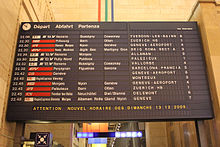

- ザ・ TGVリリア (Trainàgrandevitesse、フランス語/スイス 高速鉄道 接続)、毎日いくつかの列車が発着します パリ, ディジョン, リヨン, ヴァランス, アヴィニョン, エクスアンプロヴァンス, マルセイユ, トゥーロン, カンヌ, アンティーブ、および ニース.
- 移動時間の例: パリ-ジュネーブ3時間、-ローザンヌ3時間半、-バーゼル3時間、-ベルン4時間、-チューリッヒ4時間;
- そして ジュネーブ-リヨン2時間、-アビニョン3時間、-マルセイユ3時間半、-ニース6時間半;
- バーゼル-マルセイユ5時間
- 移動時間の例: ミラノ-ベルン3時間12分、-バーゼル4時間、-ジュネーブ4時間、-チューリッヒ3時間36分;
- 一日一回: ミラノ中央駅-(シンプロントンネル)-ブリッグ2時間、-(レッチュベルクベーストンネル)-シュピーツ2時間半、-ベルン3時間25分、-バーゼル4時間25分、-フライブルクi.B. 5時間、-カールスルーエ6時間、-マンハイム6時間45分、-フランクフルトa.M. Hbf7時間半;
- 一日一回: フランクフルト午前Hbf-マンハイム45分、-カールスルーエ1時間12分、-フライブルクi.B. 2時間15分、-バーゼル3時間、-ルゼルン4時間15分、-(ゴッタルドベーストンネル)-ベリンツォナ5時間48分、-ルガーノ6時間18分、-ミラノ中央7時間半
- レギュラー 氷 (インターシティ急行、ドイツの高速列車)から クール, チューリッヒ / インターラーケン 経由 ベルン, バーゼル に フライブルクi.B., オッフェンブルク, バーデンバーデン, カールスルーエ, マンハイム, フランクフルト午前 (主要鉄道駅または空港)ドイツでは、多くの人が ケルン そして ドルトムント、または ハノーバー そして ハンブルク、または ベルリン、または アムステルダム.
- 移動時間の例: フランクフルト空港-バーゼル3時間; フランクフルト午前Hbf-ベルン4時間、-インターラーケン5時間、-チューリッヒ4時間、-クール5時間24分;
- または インターラーケンオスト-ベルン52分、-バーゼル2時間、-フライブルク.i.B。 3時間、-フランクフルト午前Hbf 5時間、-ベルリンHbf9時間半(1日2回)
- 2時間ごと IC チューリッヒとチューリッヒ間の列車 シュトゥットガルト、移動時間3時間
- レギュラー ユーロシティ (EC)チューリッヒとの間の列車 ミュンヘン、移動時間4時間
- レギュラー RailJet (RJ)チューリッヒとの間の列車 インスブルック (3時間半)、 ザルツブルク (5時間半)、 ウィーン (8時間)オーストリア、さらに東へ
- 寝台列車 ÖBBがブランド名で運営 ナイトジェット
バスで
- ユーロラインズ スイスをルートネットワークに組み込んでいます。
- ボスニアのディアスポラにサービスを提供しているバス会社がいくつかあり、バルカン半島に行くための安価な方法を提供しています。 TuristikProšić 連盟のさまざまな目的地から実行されます ボスニア・ヘルツェゴビナ スイスへ。
- Flixbus 追い詰めた人 ドイツ国内市場 また、スイスとの間だけでなく、スイスを経由して近隣諸国へのサービスも提供しています。 Flixbusは、スイス国内で乗客を運ぶことを法律で禁止されており、スイス国内で搭乗する際に、国内線を予約したり、スイス国内で下車したりすることはできません。
車で
スイスの都市やスイス国内の多くの一般的な観光地へは、車で簡単にアクセスできます。フランス中部東部のジュネーブとドイツ南部のチューリッヒ。ただし、一部の観光地、特にツェルマットやヴェンゲンなどの小さな典型的なアルプスの村は車が通っていません。
スイスは現在シェンゲン協定の一部ですが、EUの税関/関税連合の一部ではありません。したがって、EU /スイス ボーダーポスト 密輸などに焦点を当て、 国境以降の道路をチェックします 所定の位置にとどまります。 Delays are usually short but cars may be stopped and no reason needs to be given, even for searches inside Switzerland.
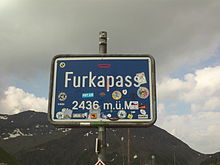
Some delay may be caused by congestion at busy times and there are often queues lasting hours to use the tunnels under the Alps from Italy such as Mont Blanc, St. Gotthard etc. Swiss motorway vignettes (40 Swiss Francs) can and should be purchased at the border if your car does not already have a valid one for the current year and you intend to use the Swiss motorways which is almost unavoidable. Most cities do not have free parking; expect to spend Fr. 25-40 for a day's parking. Some cities are entirely off-limits to cars but easily reachable by public transport, so strongly consider arriving by train instead if your final destination is one of these places.
使用する場合 mountain roads, bear in mind that they are also used by buses - most relevant on hairpin bends, which they will occupy entirely in order to get around. And most mountain roads are frequently used by the yellow Swiss PostAuto バス。 If you see a postal bus, or hear it approaching a bend by its distinctive three tone horn, hold right back (before the bend!) and let it pass, they 常に have priority and their drivers count on your cooperative driving (see also mountain road hints)!
トラムで
ザ・ バーゼル tramway system extends across the border into ドイツ (ヴァイル・アム・ライン) as well as into フランス (Saint Louis (France))。 The lines are popular with locals who shop across the border, and as Switzerland is ない part of the EU customs area, there may be customs spot checks, so don't carry anything in excess of allowed imports. Similarly the Geneva tram system also extends into neighboring France. There are plans for further cross border extensions of both tram networks, including a possible link to EuroAirport from Basel.
移動する
Getting around Switzerland is quick and easy albeit sometimes on the expensive side, no matter which mode you choose. The country has had a love affair with railways for over a century now, despite having been something of a late bloomer in railway construction. The few places not served by trains are served by the "Postauto" bus system and everything is seamlessly integrated, meaning you'll never have to wait long. Should you wish to drive a car, there are excellent highways throughout the country and many mountains are bypassed with tunnels. Hiking paths across the Alps have existed for centuries and are usually well blazed and maintained. Switzerland is also making an effort of marketing itself as bicycle friendly under the slogan "Veloland Schweiz".
飛行機で
As Switzerland has probably the most well-developed public transportation system in the world, and the country's airports are not that far apart anyway, there is very limited domestic air traffic. The connections offered by Swiss International Airlines そして Etihad Regional include Zurich-Geneva, Zurich-Lugano and Geneva-Lugano. In most cases taking the train, sometimes combined with bus or other means, will be a cheaper option, and often it may prove just as fast and convenient as flying. If you arrive on an international flight to Flughafen Zürich (in Kloten) or Genève Aéroport (in Cointrin), you may take a direct train or bus from stations integrated into the airport terminals. From there, easy connection with several means of transportation including only one or two swift transfers will bring you to many destinations
公共交通機関
主な記事: Rail travel in Switzerland

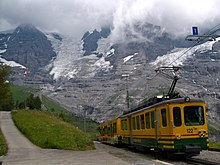
The Swiss will spoil you with fantastic transport - swift, disturbingly punctual trains, clean buses, and a half dozen different kinds of mountain transport systems, integrated into a coherent system. The discount options and variety of tickets can be bewildering, from half-fare cards to multi-day, multi-use tickets good for buses, boats, trains, and even bike rentals. In general there's at least one train or bus per hour on every route; on many routes trains and buses run every 30 or even 15 minutes. Inner-city transit often runs every 5-7 minutes during rush hour, but less frequently during weekends, particularly on Sundays and public holidays in more sparsely populated areas.
Authoritative information, routes, fares and schedules for almost all public transport can be found online on Swiss Federal Railway's (SBB CFF FFS) nation-wide coherently integrated 時刻表, or from posters and screens at any stop, or from a ticket window in any railway station. This timetable is also available as a free smart phone app。 At any railway station of any provider you can get information and tickets (at manned ticket counters) for any of the many members of the railway network of Switzerland and most bus systems, in particular PostBus Switzerland which provides オンライン 時刻表 as well with the same data.
Bus and train are legally not allowed to compete each other in Switzerland, rather quite the opposite, they are complementary to each other – besides being coordinated timetable-wise. That way, almost all inhabited village and town in Switzerland can be reached by public transport. This is actually constitutionally demanded by the 公共サービス regulations of the Swiss Confederation; 公共サービス is a particular Swiss term loosely referring to all kinds of laws, acts, and ordinances, which define the basic supply of public services and infrastructure in particular concerning postal services, telecommunication, electronic media, public transport and road infrastructure.
約20あります regional fare networks throughout the country, which incorporate many kinds of public transport (city bus, tram, metro, any kind of train, PostBus, boats, funiculars and others) by many different providers around urban centers into one single fare system、 といった ZVV in the canton of Zurich, or unireso[リンク切れ] (see also: Geneva's tpg) in the canton of Geneva and its French adjacent area, or mobilis around Lausanne in the canton of Vaud at the northern shore of Lake Geneva, パスパルトゥー in the cantons of Lucerne, Nid- and Obwalden (keyword: Titlis)。 Usually these networks sell zone-based tickets valid for a particular time frame (instead of point-to-point tickets) for journeys within their fare network borders. Many of these networks and transit operators provide their own free smartphone apps; sometimes to be found at the major city's transit company website.
Even if there is no train or city transit available, the comprehensive PostAuto/CarPostale/AutoPostale network gets you there. Where applicable, PostBus Switzerland is part of regional fare networks. You find all timetable information on SBB's online timetable, but PostBus Switzerland also provides their own free app with the same information as by SBB as well as many additional features.
Further information about the railway network in Switzerland そしてその Switzerland-wide countryside bus network is also available.
Hiking and cycling
ハイキング
As good as the Swiss train system is, if you have a little time, and you only want to travel 1-320 km, you could try downloading the free swisstopo-App with the world's best footpath maps (paper copies can also be purchased) and walk 16-31 km a day over some of the most wonderful and clearly-marked paths, whether it is in a valley, through a forest, or over mountain passes. There are more than 60,000 km of well maintained and documented hiking trails そして cycling routes.
The trails are well-planned (after a number of centuries, why not?), easy to follow, and the yellow trail signs are actually accurate in their estimate as to how far away the next hamlet, village, town or city is — usually given in terms of time, not distance. Once you've figured out how many kilometers per hour you walk (easy to determine after a day of hiking), you can adjust these estimates up and down for your speed.
There are plenty of places to sleep in a tent; but don't pitch one on a seemingly pleasant, flat piece of ground covered by straw–that's where the cows end up sleeping after a lazy day of eating, and they'll gnaw at your tent string supports and lean against your tent sides. And definitely don't do this during a rainstorm!, lots of huts on mountain tops, B&Bs on valley floors, or hotels in towns and cities. You could even send your luggage ahead to the next abode and travel very lightly, with the necessary water and Swiss chocolate!
自転車で
主な記事: Cycling in Switzerland
Since there is a network of straightforward cycling routes around Switzerland, it is a good place for cycling whether you're going cross-country or travelling around one of the cities. You can get information about cycling routes from Swiss Singletrail Maps そして Veloland Schweiz.
サイクリング in cities is safe and very common, and includes plenty of options like electric vehicles and free "rentals". If you decide to cycle in a city, understand that you will share the road with public transport. Beware of tram tracks which can get your wheel stuck and send you flying into traffic, and of course keep an eye out for the trams themselves and the buses, which make frequent stops in the rightmost lane and always have right of way.
による Swiss traffic law, a bicycle is considered as a road vehicle, therefore it is prohibited to cycle on sidewalks and foot paths, except for when explicitely indicated otherwise! As a bicycler you have to follow the same rules (and rights) as any other traffic member, such as cars and lorries. Therefore make sure you know the extensive Swiss traffic rules そして traffic signs.
Inline skating
Besides the main types of transport, the adventurous person can see Switzerland by in-line skating. There are three routes, measuring over a combined 600 km (350 mi) designed specifically for in-line skating throughout the country. They are the Rhine route, the Rhone route, and the Mittelland route. These are also scenic tours. Most of the routes are flat, with slight ascents and descents. The Mittelland route runs from Zurich airport to Neuenburg in the northwest; the Rhine route runs from Bad Ragaz to Schaffhausen in the northeastern section of the country. Finally, the Rhone route extends from Brig to Geneva. This is a great way to see both the countryside and cityscapes of this beautiful nation. Information about the routes can be found in the skating section of SwitzerlandMobility
車で
- For more details, see スイスでの運転
If you like cars, Switzerland can seem like a bit of a tease. It offers some of the greatest driving roads in the world, but you can literally end up in jail for speeding, even on highways. Traffic rules are strictly enforced. If you stick to the road rules and especially the speed limits, the back roads/mountain roads will still be a blast to drive on, while making sure you are not fined or arrested. Driving can be a good way of seeing the country and the vista from some mountain roads makes it worth the cost and hassle.
Driving on mountain roads requires special skill: be sure to read the in the "mountain road tips" in the Driving in Switzerland article.
Don't Think You'll Speed Undeterred Driving rules are strictly enforced and the police will pursue fines even if you live abroad - this includes speeding fines! |
いつもの speed limits in Switzerland are 120 km/h (75 mph) on motorways, 100 km/h on expressways, 80 km/h (50 mph) on main roads outside towns and in tunnels, and 50 km/h (31 mph) limit in villages and towns. You may see different speed limits signposted, including 30 km/h (19 mph) and 20 km/h (12 mph) in built-up areas.
Most drivers will need to buy a ビネット, a sticker which costs Fr. 40 that allows you to use motorways and expressways as much as you like for the entire year.
Motorists in Switzerland are required to switch on their headlights or daytime running lights at all times while driving or risk a Fr. 40 fine.
見る
The seven wonders

- ザ・ 1 Château Chillon: a castle near モントルー
- ザ・ 2 Lavaux vineyards: on the shore of Lake Geneva
- ザ・ 3 Castles of ベリンツォーナ: in the southern canton of ティチーノ
- ザ・ 4 Abbey of ザンクトガレン
- ザ・ 5 Top of Europe and the Sphinx observatory: a "village" with a post office on the 3,500-metre-high Jungfraujoch above Wengen
- ザ・ 6 Grande Dixence: a 285-metre-high dam, south of シオン
- ザ・ 7 Landwasser viaduct: on the railway between クール そして サンモリッツ
The seven natural wonders

- ザ・ 8 マッターホルン: seen from Schwarzsee, the Gornergrat or simply from the village of ツェルマット
- ザ・ northern walls of the Jungfrau and Eiger: two of the most celebrated mountains in the Alps, they can be seen from the valley of Lauterbrunnen or from one of the many surrounding summits that can be reached by train or cable car
- ザ・ 9 Aletsch Glacier: the longest in Europe. The Aletsch forest sits above the glacier, which is best seen from above Bettmeralp
- ザ・ 10 lakes of the Upper エンガディン: in one of the highest inhabited valleys in the Alps near the Piz Bernina, the lakes can all be seen from Muottas Muragl
- ザ・ 11 Lake Lucerne: seen from Pilatus above ルツェルン
- ザ・ 12 Oeschinensee: a mountain lake above カンダーステッグ
- ザ・ 13 ライン滝: the largest in Europe, where you can take a boat to the rock in the middle of the falls
行う
- 参照: スイスのウィンタースポーツ

Switzerland is renowned the world over for downhill skiing, and the country is also great for many other outdoor activities, including ハイキング そして マウンテンバイク。 Mountain climbing from easy to very hard can also be found in Switzerland and there is hardly a place with a longer tradition for it. Some routes, like the North face of the Eiger ("Eiger-Nordwand" in German) have become near-mythical due to the hardships, sacrifice and even deaths suffered by the first people to climb them. And because of the breathtaking views, travelling from one place to another by car, bus, train or bike along Alpine roads and railroads is often an experience in itself.
購入
お金
Exchange rates for Swiss franc As of March 2020:
為替レートは変動します。これらの通貨およびその他の通貨の現在のレートは、 XE.com |
Switzerland's currency is the Swiss franc (または フランケン、または フラン、または franco, depending in which language area you are), denoted by the symbol "神父" or sometimes "SFr." (ISO code: CHF) It is divided into 100 Rappen, centimes, or centesimi. However, some places - such as supermarkets, restaurants, tourist attraction ticket counters, hotels and the railways or ticket machines - accept euro bills (but no coins) and will give you change in Swiss francs or in euro if they have it in cash.
Many price lists contain prices both in francs and in euros. Usually in such cases the exchange-rate is the same as official exchange-rates, but if it differs you will be notified in advance. Changing some money to Swiss francs is essential. Money can be exchanged at all train stations and most banks throughout the country. After an experiment with a "fixed floor" for the exchange rate (meaning in practice that one euro would always be at least 1.20 francs) the Swiss Central Bank decided in early 2015 to let the franc float freely once more. This, along with speculation regarding the future of the euro and the Swiss franc being seen as a "safe" currency, has led to skyrocketing exchange rates for the franc and, consequently, prices for the visitor.

Switzerland is more cash-oriented than most other European countries. It is not unusual to see notes being paid using Fr. 200 and Fr. 1000 banknotes. There are a few establishments which do not accept credit cards, so check first. When doing credit card payments, carefully review the information printed on the receipt (details on this can be found in the "Stay Safe" section below). All ATMs accept foreign cards, getting cash should not be a problem.
Coins are issued in 5-Rappen/centime (brass coloured), 10-Rappen/centime, 20-Rappen/centime, ½-franc, 1-franc, 2-franc, and 5-franc (all silver coloured) denominations. One-centime coins are no longer legal tender, but may be exchanged until 2027 for face value. Two-centime coins have not been legal tender since the 1970s and are, consequently, worthless. Most exchange offices don't accept coins and the biggest coin (5 francs) is worth roughly about US$5 or €5, so spend them or give them to charity before leaving.
Banknotes are found in denominations of 10 (yellow), 20 (red), 50 (green), 100 (blue), 200 (brown), and 1000 francs (purple). They are all the same width.
- Ninth series

神父10, front

神父10, back

神父20, front

神父20, back

神父50, front

神父50, back

神父200 Front

神父200 back
Since 2016 the Swiss National Bank SNB has been releasing a new series of bank notes, the ninth series in the modern history of Switzerland。 They started with the 50-francs note on 11 April 2016, the new 20-francs banknote followed on 17 May 2017, the new 10-francs banknote followed on 10 October 2017 and the new 200-francs banknote followed on 22 August 2018 The other denominations will be replaced step by step during the next years. All banknotes of the eighth series can still at least be exchanged at banks (no end date known 2019).
銀行
Switzerland has been renowned for its banking sector since the Middle Ages. Due to its historical policy of banking secrecy and anonymity, Switzerland has long been a favourite place for many of the world's richest people to stash their assets, sometimes earned through questionable means. Although current banking secrecy laws are not as strict as they used to be, and anonymous bank accounts are no longer allowed, Switzerland remains one of the largest banking centres in Europe. Opening a bank account in Switzerland is straightforward, and there are no restrictions on foreigners owning Swiss bank accounts—except for US citizens. Since the latest sanctions by the US, many Swiss banks refuse to open a bank account to US citizens or anyone having connections to the US. In some cases, even existing accounts have been closed.
The largest banks in Switzerland are UBS そして Credit Suisse.
チップ
Swiss service personnel enjoy a relatively highly set minimum wage compared to other countries, so チップ are rather modest. By law, a service charge is included in the bill. Nevertheless, if you feel satisfied, especially in restaurants, you may round up the bill and add a few francs with a maximum of 5–20 francs depending on the kind of establishment, regardless of bill size. If you were not happy with the service, you needn't tip at all. If you just drink a coffee, it is common to round up the bill to the nearest franc, but some people are still quite generous. Tipping is always your personal contribution and never legally requested.
費用
Switzerland is an 高価な country with prices comparable to Norway. Apart from soft drinks, electronics and car fuel, many things cost more than in the neighboring countries, particularly groceries, souvenirs, train tickets and accommodation. In fact, many Swiss people living near the borders drive into neighbouring countries to purchase fuel and groceries, as it is usually significantly cheaper; a trend that has only increased with the Franc soaring in exchange rate compared to the euro. Whilst, there are no systematic immigration controls thanks to the Schengen agreement, there are random custom checks, even inside the country, since Switzerland is ない part of EU Customs Union, so you must clear customs. Therefore make sure you comply with Swiss custom regulations for importing goods.
"Swiss-made": souvenirs and luxury goods

Switzerland is famous for a few key goods: watches, chocolate, チーズ, and Swiss Army knives.
- 時計 - Switzerland is the watch-making capital of the world, and "Swiss Made" on a watch face has long been a mark of quality. While the French-speaking regions of Switzerland are usually associated with Swiss watchmakers (like Rolex, Omega, and Patek Philippe), some fine watches are made in the Swiss-German-speaking region, such as IWC in Schaffhausen. Every large town will have quite a few horologists and jewellers with a vast selection of fancy watches displayed in their windows, ranging from the fashionable Swatch for Fr. 60 to the handmade chronometer with the huge price tag. For fun, try to spot the most expensive of these mechanical creations and the ones with the most "bedazzle!"
- チョコレート - Switzerland may always have a rivalry with ベルギー for the world's best chocolate, but there's no doubting that the Swiss variety is amazingly good. Switzerland is also home to the huge Nestlé food company. If you have a fine palate (and a fat wallet) - you can find two of the finest Swiss chocolatiers in チューリッヒ: Teuscher (try the champagne truffles) and Sprüngli。 For the rest of us, even the generic grocery store brand chocolates in Switzerland still blow away the Hershey bars. For good value, try the Frey brand chocolates sold at Migros. If you want to try some real good and exclusive Swiss chocolate, go for the Pamaco chocolates, derived from the noble Criollo beans and accomplished through the original, complex process of refinement that requires 72 hours. These are quite expensive though; a bar of 125g (4 oz) costs about Fr. 8. For リンツ fans, it is possible to get them as cheaply as half the supermarket price by going to the Lindt factory store in Kilchberg (near Zurich). Factory visits are also possible at Frey near Aarau, Läderach in Bilten and Cailler in Broc.
Holey moley! Have you ever wondered why Swiss cheese, known locally as Emmentaler, always has those distinct holes? Bacteria are a key part of the cheesemaking process. They excrete huge amounts of carbon dioxide which forms gas bubbles in the curd, and these bubbles cause the holes. |
- チーズ - many regions of Switzerland have their own regional cheese speciality. Of these, the most well-known are Gruyère and Emmentaler (what Americans know as "Swiss cheese"). Be sure to sample the wide variety of cheeses sold in markets, and of course try the cheese fondue! Fondue is basically melted cheese and is used as a dip with other food such as bread. The original mixture consists of half Vacherin cheese and half Gruyère but many different combinations have been developed since. If you're hiking, you will often come across farms and village shops selling the local mountain cheese (German: Bergkäse) from the pastures you are walking across. These cheeses are often not sold elsewhere, so don't miss the chance to sample part of Switzerland's culinary heritage.
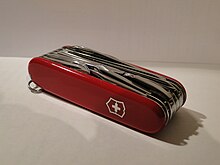
- Swiss Army knives - Switzerland is the official home of the Swiss Army knife。 There are two brands: Victorinox and Wenger, but both brands are now manufactured by Victorinox since the Wenger business went bankrupt and Victorinox purchased it in 2005. Collectors agree Victorinox knives are superior in terms of design, quality, and functionality. The most popular Victorinox knife is the Swiss Champ which has 33 functions and costs about Fr. 78. Most tourists will purchase this knife. The "biggest" Victorinox knife is the Swiss Champ 1.6795.XAVT- This has 80 functions and is supplied in a case. This knife costs Fr. 364 and may be a collector's model in years to come. Most shops throughout Switzerland stock Victorinox knives, including some newsagents and they make excellent gifts and souvenirs. Unlike the tourists' knife, the actual "Swiss Army Knife" is not red with a white cross, but gray with a small Swiss flag. The Swiss Army issue knife is also produced by Victorinox. It is distinguished by having the production year engraved on the base of the biggest blade, and no cork-screw because the Swiss soldier must not drink wine on duty. Swiss Army Knives can not be carried on board commercial flights and must be packed in your hold baggage.
Ski and tourist areas will sell many other kinds of touristy items: cowbells, clothing embroidered with white Edelweiss flowers, and ハイジ-related stuff. Swiss people love cows in all shapes and sizes, and you can find cow-related goods everywhere, from stuffed toy cows to fake cow-hide jackets. If you have a generous souvenir budget, look for fine traditional handcrafted items such as hand-carved wooden figures in ブリエンツ, and lace and fine linens in St. Gallen. If you have really deep pockets, or just wish you did, be sure to shop on Zurich's famed Bahnhofstrasse, one of the most exclusive shopping streets in the world. If you're looking for hip shops and thrift stores, head for the Niederdorf or the Stauffacher areas of Zurich.
食べる
- 参照: 中央ヨーロッパ料理
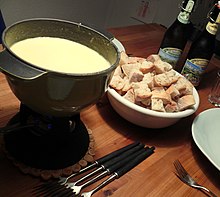
While Switzerland has had long culinary exchange with the cuisine of its neighbours, it has several iconic dishes of its own.
Switzerland is famous for many kinds of チーズ お気に入り Gruyère, Emmentaler (known simply as "Swiss cheese" in the U.S.), and Appenzeller, just to name a very few of the about 450 kinds of cheese of Swiss origin. Two of the best known Swiss dishes, フォンデュ そして raclette, are cheese based. Fondue is a pot of melted cheese that you dip pieces of bread into using long forks. Usually fondue is not made of one single type of cheese, but instead two or three different cheeses are blended together with white wine, garlic and kirsch liqueur with regional variations. The most popular blend of cheese varieties is called moitié-moitié and consists of equal parts Gruyère AOP and Vacherin Fribourgeois AOP. Traditionally fondue is eaten during cold periods at altitude with one pot for the whole table, served with hot black tea and hardly any additional side dishes - not surprising, since it used to be a cheap and often the only dish for a herdsman high up in the mountains far away from civilization with only basic equipment. However you can now get fondue for one person during the summer time in tourist-oriented restaurants. Another cheese dish, raclette, is made by heating a large piece of cheese and scraping off the melted cheese, which is then eaten together with boiled potatoes and pickled vegetables. Cheese-lovers should also try Älplermakkaronen, Alpine herdsmen's macaroni with melted cheese and potato served with apple compote which is another very simple but very tasty dish originally from central Switzerland.
Another typically Swiss dish is Rösti, a potato dish quite similar to hash browns. Originally, it is a dish from German-speaking Switzerland, and it gives its name to the colloquial political term Röstigraben (lit.: Rösti ditch) which refers to the quite different political preferences and voting habits of the German-speaking and the French-speaking part of Switzerland.
Probably the best known meat dishes are the incredibly common sausage known as Cervelat, usually grilled on a stick over an open camp fire, and the speciality of region around Zürich, Zürcher Geschnetzeltes (or in the local dialect: Züri Gschnätzlets), sliced veal in a mushroom sauce usually accompanied by Rösti. Very typical for Lucerne is the Luzerner Kugelpasteten (or in the local dialect: Lozärner Chügelipastete), is Brät (less expensive meat, minced, mixed with water and egg) formed as small balls, served in puff-pastry baskets, and poured with a ragout made of meat, agaricus mushrooms and raisins. In French-speaking Switzerland you will find the saucisse aux choux そして saucisson vaudois and around Basel the liver dish Basler Leber(li) (or in the local dialect: Baasler Lääberli)。 Bern is known for the Berner Platte (lit.: Bernese Plate), a dish comprising various pork products, boiled potatoes, Sauerkraut (cabbage), and dried beans, besides others. This was traditionally an autumn dish, since the slaughter historically used to happen when weather was cold enough again to prevent any spoiling of the meat. The slaughter season and their dishes are called Metzgete in the German part of Switzerland and is still prominent on the menus of rural restaurants during this season.
If you instead prefer fish to meat, Swiss restaurants often serve the freshwater fish found in the many rivers and lakes. The most common fish dishes among the 55 kinds of Swiss fish include trout, European perch, or the whitefish known as (Blau-)Felchen, corégone/féra、または coregone blaufelchen respectively, cooked in a variety of ways. However, you will also find many imported fish on Swiss menus, since the domestic business (fished or bred) can never fulfill the strong demand for fish. Also, because the fish haul has become about a third smaller than 30 years ago, exclusively due to the much better quality of water nowadays; from this point of view, Swiss water is too clean!
In autumn, after hunting season, you will find many fabulous ゲーム そして mushroom 料理。 Many traditional game dishes come with Chnöpfli (lit.: diminutive of knobs; a soft egg noodle), red cabbage or Brussel sprouts, cooked pears and are topped with mountain cranberry jam. However, nowadays the game (venison, roe, chamois, boar, rabbit) mainly originates from farms in order to fulfill the high demand.
The mountain region of Graubünden has a distinctive culinary repertoire, including capuns (rolls of Swiss chard filled with dough and other ingredients), pizokel dumplings, the rich and creamy barley soup Gerstensuppe, and a sweet dense nut pie called Bündner Nusstorte。 Also from this region is a thinly-sliced cured meat known as Bündnerfleisch。 Most mountain areas in Switzerland produce their own cured and air-dried meats and salamis which are highly recommended.
The canton of Appenzell in eastern Switzerland is known for various sausage dishes, including Appenzeller Siedwurst そして Appenzeller Bauernschüblig。 Another favorite meat delicacy are Appenzeller Mostbröckli, a type of spiced, cured and smoked beef. The local cheese is branded as Appenzeller Käse and is supposedly made from a secret recipe. On the sweet end of the spectrum, Appenzeller Bärli-Biber is a soft gingerbread with an almond filling, and Landsgmendchrempfli is a sugar and egg based pastry filled with hazelnut paste.
It is very easy to come by high-quality Italian cuisine in Switzerland, but when in Italian-speaking Ticino be sure to try the local specialities based around polenta (a corn dish), リゾット (the rice of the same name is exclusively cultivated in Ticino and northern Italy), and many kind of marroni (chestnuts) dishes in Autumn, either as part of a cooked meal, or simply roasted during very cold winter days in the streets, or as a special sweet dessert called vermicelles.
Swiss chocolate is world famous and there is a large range of different chocolate brands.
The well-known breakfast dish Müesli comes from Switzerland, actually originally called Birchermüesli, is well-worth trying - oats soaked in water, milk, or fruit juice and then mixed with yoghurt, fruits, nuts and apple shavings.
Of course, there are many more local and traditional dishes and meals to be found, which can not all be listed. There is a whole site dedicated solely to the Culinary Heritage of Switzerland by canton, though only available in one of the official Swiss languages.
Like most other things, eating out is 高価な スイスの。 One way to reduce food costs is to eat in the cafeterias of department stores such as Coop, Migros, and Manor. These cafeterias are usually considerably less expensive than stand-alone restaurants. Coop and Manor also offer beer and wine with meals while Migros does not. Smaller department store outlets might not have a cafeteria. Kebab shops and pizza restaurants abound in urban Switzerland, and these are often cheap options. In the major cities, more exotic fare is usually available - at a price.
Supermarket chains
Swiss employment law bans working on Sundays, so shops are closed. An exception is any business in a railway station, which is deemed to be serving travellers and so is exempt. If you want to find an open shop on a Sunday, go to the nearest big railway station. If a business is a family owned, hence small shops, such as bakeries namely, can also open on Sundays in most cantons.
Swiss supermarkets can be hard to spot in big cities. They often have small entrances, but open out inside, or are in a basement, leaving the expensive street frontages for other shops. Look for the supermarket logos above entrances between other shops. Geneva is an exception and you usually don't have to go very far to find a Migros or Coop.
The most important supermarket brands are:
- ミグロス - This chain of supermarkets (a cooperative) provides average-to-good quality food and non-food products and homeware. However, they do not sell alcoholic beverages or cigarettes. Brand name products are rare as the chain does their own brands (quality is good). Migros stores can be spotted by a big, orange Helvetica letter "M" sign. The number of "M" letters indicates the size of the store and the different services available - "M" is usually a smaller grocery store, "MM" may be larger and sells other goods like clothing, and a "MMM" is a full department store with household goods and possibly electronics and sporting goods. Offers change weekly on Tuesdays.
- コープ - Also a cooperative. Emphasis on quality as well as multi-buy offers, points collection schemes and money off coupons. Sells many major brands. Come at the end of the day to get half-priced salads and sandwiches. Coop City is usually a department store with a Coop grocery store inside, a multi-floor layout provides space for clothing, electrical items, stationary, paperware as well as beauty products and perfume. Offers change weekly (some exceptions - fortnightly), on Tuesdays.
- デナー - A discount grocery store, noticeable for their red signs and store interiors. Relatively low priced. Offers change weekly, usually from Wednesday. Denner is owned by Migros.
- Coop Pronto - a convenience store branch of Coop, usually open late (at least 20:00) seven days a week. Usually has a petrol, filling-station forecourt.
- Aperto - also a convenience store, located in the railway stations. Owned by Coop, it sells more or less the same products as Coop Pronto.
- マナー - the Manor department stores often have a grocery store on the underground level.
- Globus - in the largest cities the Globus department stores have an upscale grocery store on the underground level.
Coop offers a low-price-line (Coop Prix-Garantie) of various products, and in Migros you can find the corresponding "M-Budget" products. Sometimes it's exactly the same product, just for cheaper price. They also offer cheap prepaid mobiles some of the cheapest call rates.
The German discounters アルディ そして Lidl are also present in Switzerland. The prices are a little lower than at the other supermarket chains, but still significantly higher than in Germany.
ドリンク
Virtually all tap 水 – including that in households or hotel rooms – is perfectly drinkable, thoroughly and frequently monitored, and of excellent quality. About 85% of Swiss residents drink tap water daily; there is no need to buy drinking water. There are many drinking water fountains to be found, especially in towns and villages, e.g. in Zurich more than 1200, or in Basel about 170. The few exceptions, such as in train toilets, are clearly signed with "Kein Trinkwasser" (German), "Non potable" (French), or "Non potabile" (Italian). Temporarily installed troughs on mountain meadows used to water the cattle are also not suitable for drinking.
Soft drinks in supermarkets are one of the few things that aren't notably more expensive than elsewhere in Central Europe. Local specialties are the lactose-based soft drink Rivella and the lemon-flavoured Elmer Citro.
Switzerland produces a surprisingly large amount of ワイン, with the climate and soil well-suited to many grape types. Very little of this wine is exported and is very reasonably priced in the supermarkets, so it is well worth trying!ザ・ Lake Geneva region is particularly famous for its wines, and the picturesque vineyards are worth visiting for their own right. However, wines are made throughout the country in Valais, Vaud, Ticino, Neuchâtel, the Lake Biel region, Graubünden, Aargau, Thurgau, Schaffhausen and even on the hills around Zurich and Basel - why not try a glass from your next destination?
Unfortunately, all the major Swiss ビール breweries have lost their Swiss origins because they have been acquired by major international corporations (e.g. Feldschlösschen belongs to Carlsberg, Eichhof and Calanda Bräu belong to Heineken). As a consequence, many other still Swiss breweries (e.g. Löwenbräu was taken over by Hürlimann, Hürlimann was taken over by Feldschlösschen, Warteck Bier and Gurten Bier was integrated into Feldschlösschen, Cardinal was taken over by Feldschlösschen-Hürlimann, now Carlsberg; Ziegelhof was acquired by Eichhof, Haldengut was integrated into Calanda Bräu, now Heineken) were consolidated and further closed due to too weak economics strength. But as a kind of constructive protest, many small, local breweries with new beers emerged around and after the turn of the millennium. 当時のエコノミストの激しい推奨に反して、多くのスイス人が大規模な醸造所に背を向けたため、これは大成功でしたが、これらの多くも 地元の小さな醸造所 より良いビールを醸造するだけです。コープでビールを見つけた場合、それはもはや若い野生の起業家のものではないと推測できます。 地元の人にどのビールがいいか聞いてください、しかし外国人ではありません!
睡眠
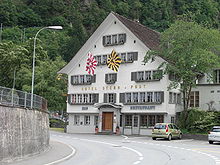
現在、スイスのほとんどの宿泊施設は、主要なインターネット予約サイト、さらには遠隔地のホテルや小屋で見つけて予約することができます。それでも、スイスのほとんどの観光地には観光案内所があり、そこに電話して小額の料金でホテルを予約してもらうことができます。通常、各町のWebサイトにはホテルの包括的なリストがあり、ホテルに直接予約する方が簡単で安価な場合がよくあります。一部のホテルでは、予約を確保するために、クレジットカード情報をFAXまたは電子メールで送信するように要求します。一般的に、ホテルのスタッフは親切で有能で、英語をとても上手に話します。
ほとんどのヨーロッパ諸国と同様に、スイスは幅広い宿泊施設の可能性を提供しています。これらは、5つ星ホテルからキャンプ場、ユースホステル、干し草で寝ているところまであります。スイスのホテルの種類には、歴史的なホテル、伝統的なホテル、国内にある旅館、スパ、ベッド&ブレックファーストが含まれます。
他のヨーロッパ諸国と比較して、スイスの宿泊施設は一般的に高価です。スイスのホテル料金は、特に人気のあるスキーリゾートエリアや主要都市ではかなり高くなる可能性があります。
経験則として、次の価格を使用できます。
- 5つ星ホテル:神父からお一人様一泊350
- 4つ星ホテル:神父からお一人様/泊180
- 3つ星ホテル:神父から1人1泊あたり120
- 2つ星ホテル:神父からお一人様/泊80
- ホステル:神父からお一人様/泊30
スイスのホテルスターは、 hotelleriesuisseスイスホテル協会。 hotelleriesuisseのすべてのメンバーは、ホテルのスターを取得するために定期的な品質テストを受ける必要があります。オン swisshotels.com ホテルのスター、インフラストラクチャ、専門分野に関する情報を見つけることができます。
ヒントはすべてのサービスに含まれています。特別な努力のために、通常は合計を切り上げることによる小さなヒントはいつでも歓迎です。
もあります ホステル 学生のためのスイスのネットワーク、の価格 スイスユースホステル[リンク切れ] 通常のヨーロッパレベルです。
学ぶ
スイスには、チューリッヒのETH、ジュネーブのIHEID、ローザンヌ大学、ザンクトガレン大学(HSGとも呼ばれます)など、世界的に有名な大学がいくつかあります。フランス語、ドイツ語、イタリア語のいずれも話せない場合は、最初に語学コースを受講することをお勧めします。多くのコースでは、現地の言語を非常に上手に習得する必要があります。特に修士レベルで英語で教えられるコースがいくつかありますが、学士号のコースはほとんどすべて現地の言語で教えられ、調べられます。また、外国人で人気のある科目を履修したい場合は、入学試験に合格しなければならない場合があり、生活費が非常に高くなることにも注意してください。
より安価な学習が好きな場合は、Migros Klubschuleを利用してください。MigrosKlubschuleは、ほぼすべての言語の語学コースと、多くの科目のさまざまなコースを提供しています。見てください 彼らのウェブサイト。また、非常にリーズナブルな料金で多種多様な科目を提供するさまざまな「フォルケホイスコーレ」を試してみることもできます( チューリッヒのもの、 例えば)。
大人またはジュニア向けの質の高いフランス語コースをお探しの場合は、スイスでフランス語を学ぶことができます。 アルパディアスクール (以前のESLスクール)。 LSI(Language Studies International)を選択して、多くの学校の1つに行くこともできます。 広範なネットワーク スイスでフランス語を学ぶ。スイス当局はあなたが神父を使うことができると期待しています。年間21,000人で、通常、ビザ申請を受け入れるにはそれぞれの承認が必要です。一部の人にとっては、これは多くのように聞こえるかもしれませんが、それでもこの量だけで非常に穏やかな学生の生活を送ることができます。
作業
あなたがスイスで働きたいと思っていて、あなたがスイス国民でないなら、あなたは 労働許可を取得する必要があります。これらの許可の資格と条件は、国籍、資格、仕事自体によって異なります。事前に雇用主の州に確認してください。 EU / EFTA加盟国の国民 最大3か月間機能する可能性があります 許可なしで、しかしそれでも当局に彼らの雇用を登録する必要があります。
スイスの失業率は約3.3%です(2015年)。スイスの高水準の給与は生活費の高さを反映しているため、給与を交渉する際には宿泊施設や食事に多額の費用をかける必要があります。一般的に、あなたは名目上42時間/週働き、4週間の有給休暇があります。
スイスには一般的な法定最低賃金はありません。給与はあなたが働いている業界によって異なりますが、レストランやホテル業界などの一部の業界では、最低でもFrを支払っています。月額フルタイムの仕事(購買力平価US $ 2100、2016年8月)で総額3134。しかし、これは公式の貧困レベルをはるかに上回っていません。スイスで外食が安くない理由の1つでもあります。契約で別段の合意がない限り、残業は通常、低レベルの仕事に対して支払われます。
業界別の平均給与をチェックしたり、適切な金額が支払われていることを確認したりする場合、スイスの従業員は労働組合で大規模に組織されています SGB そして常にあなたを助けたいと思っています。雇用主に問題がある場合は、それぞれの組合が助けを探すのに適した場所です。
2014年2月、スイス国民は、政府が割当を使用して移民を管理することを要求する国民投票を狭義に承認しました。スイスは以前、EUと(ほぼすべての)EU加盟国の市民が国内で働くことを許可する協定を結んでいました。国民投票に続いて、スイスとEUは、スイス人であろうと外国人であろうと、特定の地域の特定の仕事を国の居住者が最初に利用できるようにするスキームに合意しました。したがって、国民投票後、実際にはほとんど変わっていません。
おげんきで
スイスはヨーロッパで最も安全な国の1つですが、ロレックスを身に着けている銀行家や気が散る観光客の群衆を引き付ける場所ならどこでも、いくつかを引き出すでしょう スリ。明らかに、特に夏の混雑の真っ只中には、所持品に注意してください。一般的に、あなたはいつでもどこでも安全です。何らかの理由で脅迫されていると感じた場合は、近くのレストランまたは電話ブースを探してください。スイスの緊急電話番号は112で、オペレーターは一般的に英語を話します。
かなりの数のスイスの施設があなたを印刷します 全体 クレジットカード番号をレシートに記載しているため、スイスでクレジットカードを使用して買い物をする際に個人情報の盗難の懸念が生じます。したがって、クレジットカードを使用する訪問者は、すべてのレシートに印刷されている情報を注意深く確認してから破棄する必要があります。これは、たとえば、一部の本屋や衣料品店、さらにはどこにでもあるK-Kioskでも発生します。このリストは明らかに網羅的ではありません。したがって、訪問者はクレジットカードを使用するときは常に注意する必要があります。
一人旅の女性は問題ないはずです。若いスイス人は愛情表現で非常にオープンである傾向があります-時にはオープンすぎます、そして何人かの女性は人々が特にクラブ&バーシーンの未明の時間にあまりにも友好的になるのを見つけるかもしれません。通常、ブラッシュオフまたはただ立ち去るという国際的な言葉で十分です。
スイスの警察は比較的目立たない空気を取ります。彼らは、自分たちの存在が環境全体を脅かす可能性があると考えているため、舞台裏に留まることを好みます。いくつかのより厳重に警備されている国とは異なり、警官が民間人に助けが必要かどうかを尋ねたり、単にパトロールによって彼らの存在をマークしたりすることはめったにありません。しかし、警察は確かに交通違反に真剣に取り組んでいます。たとえば、ジェイウォーキングや赤い歩行者用ライトの交差は、その場で罰金が科せられます。厳格な交通ルールの利点は、車の運転手は一般的に非常によく訓練されており、交差点で歩行者のためにすぐに立ち寄ることです。サッカーゲームは上記のルールの唯一の注目すべき例外です。フーリガンによる暴力の潜在的な脅威があるため、これらのゲーム(特にバーゼルまたはチューリッヒ)では、大規模な不安が発生した場合に備えて、暴動鎮圧用装備、ゴム弾、催涙ガスを備えた警察官の大規模な派遣団が一般的に続きます。
スイスには非常に強力な善きサマリア人の法律があり、自分を過度に危険にさらすことなく、困っている人を助けることは市民の義務となっています。したがって、あなたが緊急事態にあるように見える場合、人々は非常に喜んであなたを助ける準備ができています。あなたが危険にさらされている人を目撃した場合も同じことが言えます。困っている人を助けることを拒否することは、法律によって「Verweigerung der Hilfeleistung」、つまり援助の拒否として罰せられる可能性があります。将来の民事責任の可能性による見知らぬ人との絡み合いを避けるためのアメリカ人の一般的な留保は、スイスでは適用されません。援助を提供する人に対して民事訴訟を起こすことは事実上不可能だからです。
ビール、ワイン、サイダーの飲酒年齢は16歳ですが、ティチーノ州では18歳ですが、その他のアルコール(スピリッツ、「アルコップス」など)の年齢は18歳です。合法であるため、公共施設や公共交通機関で6パックを飲んでいるティーンエイジャーのグループを見ても心配しないでください。これは決して異常なことではなく、脅迫的であると解釈されるべきではありません。
スイスは、ばかげた民事訴訟や損害賠償請求の国ではありません。したがって、何かをしないように指示する標識または免責事項が表示された場合は、それに従ってください。例:多くのアルプス地域では、魅力的な小さな渓流の横に「水泳禁止」というメッセージの標識が付いている場合があります。初心者には、これは少し上に見えるかもしれませんが、これらの兆候は、警告なしに大量の水を放出する可能性のあるさらに上流の水力発電所の存在の結果です。
山岳地帯では、朝出かける際に必ず観光案内所や地元の駅で気象条件を聞いてください。彼らは厳しい気象条件について十分に知らされるべきであり、雪崩の可能性のある地域についてあなたに助言するでしょう。
IDカードまたはパスポートを持たない黒人、東ヨーロッパ人、またはアラブ人は不法移民であると想定し、それに応じて彼らを扱う警察には問題がありました。あなたが一人で旅行している場合、それはかなりの問題になる可能性があります。したがって、法的に義務付けられていない場合でも、IDカードまたはパスポートを携帯しておいてください。ただし、警察はいつでも身分証明書を要求する法的権利を有しており、身分証明書やパスポートを提示できない場合は、身分証明書として警察署に連れて行くことができます。すべてのスイス人と同じように、IDカード(またはパスポート)を携帯してください。
健康を維持する
一般的にスイスでは食べ物や水に問題はありません。レストランは厳格な規則によって管理されています。 水 「KeinTrinkwasser」、「Non potable」、「Non potabile」と明示的にマークされていない限り、すべての蛇口からでも、特に公共の噴水からでも、どこでも飲むことができます。近くの小川のそばにいる牛に水をやるために、牧草地に一時的に設置されたトラフから飲まないでください。
ほぼすべての食料品店で、次のようにラベル付けされた多くの有機食品が入手可能です。 バイオ、および遺伝子組み換え食品を輸入および販売することは違法です。
スイスには病院と診療所の密集したネットワークがあり、公立病院は緊急時にあなたを受け入れます。チューリッヒ、バーゼル、ルツェルンなどの主要鉄道駅には、24時間体制の「常設」クリニックがあり、予約なしで緊急でない病気の治療を行うことができます。治療費はすぐに高くなる可能性があるため、これらの費用を自己負担で支払うことができない場合は、十分な補償範囲の旅行保険が必要になります。
尊敬
| “ | あなたはスイス人について何も知りませんか?裁量は私たちのものの一種です。それが私たちの仕事です。 | ” |
—トレバーノア生まれの犯罪 | ||
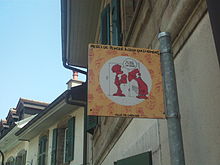
プライバシー スイスの誰かのプライバシーを不注意に侵害しないように注意してください。スイス人 民法 そして データ保護の連邦法 それは 明示的な同意なしに人を録音することは禁じられています これは、人が認識できるようになるとすぐに、写真やビデオの記録にも当てはまります。明示的な同意なしに人物の写真やその他の録音を撮影し、特に公開したことで最大3年間の懲役が科せられる可能性があるため、写真を撮る内容に注意し、一般の人々と有名人の両方のプライバシーを尊重してください。 。 |
スイスでは英語が広く話されていますが、英語で返信された場合でも、現地の言語を話そうとしても常に歓迎されます。会話を始める前に、彼らが英語を話すかどうか尋ねることは常に礼儀正しいです。少なくとも、旅行先の地域の言語で「こんにちは」、「さようなら」、「お願いします」、「ありがとう」を学ぶように努力してください。「お願いします...」もそうなるフレーズです。助けます。
ドイツ語、フランス語、イタリア語はすべて、公式および非公式の単語形式を持っています 君は、使用する動詞の活用を変更し、場合によってはフレーズを変更します。たとえば、非公式のフレーズ 心配しないで フランス語で ne t'en fais pas 正式なは ne vous en faitespas。 フォーマルは、あなたより年上の人、上司と見なされる人、職場であなたよりもランクが高い人、または単に通りにいる見知らぬ人に敬意を表するために使用されます。非公式は、親しい友人、親戚、仲間と一緒に使用されます。原則として、よく知らない人、上位の人、年長者とは非公式に使用しないでください。親しい友人や若い人たちと非公式に使用してください。ピアは灰色の領域である可能性があり、インフォーマルを使用するように求められるまで、最初はフォーマルを使用することをお勧めします。
スイスではプライバシーが高く評価されており、おそらく他のヨーロッパ諸国と比較して高く評価されています。誰かの個人的、政治的、または宗教的な信念について尋ねることは、誰かに精通するまでは立ち入り禁止の領域です。友情と人間関係は非常に深刻な問題と見なされており、知人から友情への道のりは長いものになることがよくあります。
友達は頬で左、右、左の3回キスをします。これは、フランス語とドイツ語を話す部分の誰かに紹介されるときの一般的な習慣です。ただし、ビジネス関連の会議の場合は、握手するだけです。恥ずかしがらないでください-あなたが前進を拒否した場合、それはあなたの側で厄介で失礼に見えるかもしれません。偽の「エア」キスのように、実際に唇を肌に触れる必要はありません。
ポイ捨ては特に反社会的と見なされています。一部の州では、ポイ捨てに対する罰金(約40〜80 Fr.)があり、より重い罰金を含め、ポイ捨てを一般的に違法にする計画があります。紙やPETプラスチック用の特別な容器があるものもあるので、リサイクル可能なごみは正しくラベルが貼られたビンに入れてください。一部の自治体のゴミ箱には、過度の騒音を避けるために使用する時間に制限があります。
時間厳守。もしそうなら、それは1分以内の遅れを意味します!時計を作ることで知られている国にとって当然のことながら、スイス人は時間通りにいることにほぼ執着しています-鉄道網は、他の国が達成できないと考える時間厳守の程度にさえ依存しています。
特にスイスドイツ人は、ドイツとドイツ人に対して曖昧でしばしば否定的な見方をしています。ドイツ人は騒々しく、失礼で、スイスのリラックスとは正反対だと見られています。この理由の1つは、スイスドイツ人は要求を行うときに丁寧な婉曲表現を使用することを好むのに対し、ドイツ人、特に非アレマン語のドイツ人ははるかに直接的または鈍いことです。
接続する
1990年代に登場したインターネットカフェの多くは、スイスが世界で最も高速なインターネット接続率の1つであるため閉鎖されましたが、一部の大型駅にはインターネット端末がいくつかある場合があります。観光案内所は、最寄りの観光案内所に案内できるはずです。通常のレートは神父です。 20分間5。スイス連邦鉄道(SBB CFF FFS)は現在、ステーションで無料のWLANを提供しています。
また、ほぼすべての公衆電話ブースから1フラン未満で、電子メール、SMS(携帯電話へのテキストメッセージ)、または短いテキストファックスを送信できます。一部の公衆電話ブースでは、インターネットを閲覧できます。多くのショッピングセンターや都市があります(ローザンヌ そして ヴヴェイ たとえば)無料のワイヤレスインターネットアクセスを提供するもの:若い地元の人に聞いてください。多分彼らはどこへ行くべきか知っています。
公衆電話は驚くほど安く、クレジットカードの追加料金はかかりません。
しばらく滞在する場合は、900 / 1800MHz帯域のGSM標準をサポートするすべての電話で使用できるプリペイド携帯電話カードを購入することをお勧めします。通常は約Frの費用がかかります。 10〜40で、ほとんどの都市のモバイルサービスプロバイダーSwisscom、Salt、またはSunriseのショップで入手できます。山岳地帯の人口の少ない地域でも、モバイルネットワークのカバレッジは地域ごとにほぼ100%です。
他のプロバイダーからの市内通話用の安価なプリペイドカードもたくさんあります。大手スーパーチェーンMigrosのプリペイドカード(M-予算-モバイル)とCoop(コープモバイル[リンク切れ])例えば、神父の周りの費用。 20そしてすでに神父を含みます。 15放送時間。スイス国内での通話に最も安いプリペイドカードは アルディモバイル:神父0.14 / minスイス固定、Aldi mobile、Fr。 0.34 /分他の携帯電話。国際通信用の最も安いプリペイドカードは ヤロ:神父スイス国内およびすべてのヨーロッパ諸国およびその他多くの国(モバイルおよび固定ネットワーク)で0.39 /分。これには、英国、米国、カナダ、オーストラリア、ニュージーランドが含まれます。 SMSの費用はFrです。 0.10。プリペイドカードは、オンライン(30 Fr.とFr.30の放送時間込み)、ほとんどの郵便局(Fr.29とFr.20の放送時間込み)またはサンライズショップ(Fr.20とFr.20の放送時間込み)で購入できます。安い料金の別のプリペイドカードは、Lebara Mobile(Sunriseの姉妹会社)を提供します。プリペイドカードは神父のために利用可能です。同等の通話時間とリチャージバウチャーを備えた5は、バウチャーの価格と同等の通話時間を提供します。









